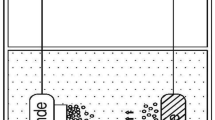Abstract
This work reports the nucleate boiling heat transfer characteristics of n-pentane on smooth and enhanced surfaces. Surface modifications were carried out on stainless steel surfaces by fabricating microholes of diameter between 0.3 and 0.7 mm arrays using electric discharge machining. Pool boiling experiments were carried out at normal atmospheric pressure. Experiments have been performed for applied effective heat flux range between 1 and 10 W cm−2. An enhancement of 20–45% in heat transfer coefficient was observed on the enhanced surface compared to the smooth surface. The heat transfer improvement in the enhanced surface can be attributed to more active nucleation sites, better rewetting phenomenon, and favorable bubble growth and release mechanism. Further changing the material from steel to brass enhances the heat transfer coefficient by 20%. This will be a viable option as a cooling technology for high-power electronic industries.











Similar content being viewed by others
Abbreviations
- q″ :
-
Heat flux (W/m2)
- T :
-
Temperature (K)
- k :
-
Thermal conductivity (W/mK).
- h :
-
Heat transfer coefficient (W/m2K)
- I :
-
Applied current (A)
- V :
-
Voltage (V)
- T w :
-
Wall temperature (K)
- T s :
-
Saturation temperature (K)
- ΔX :
-
Distance between thermocouples (m)
- δ :
-
Uncertainty
- eff :
-
Effective
- in :
-
Input
- CHF:
-
Critical heat flux
- HTC:
-
Heat transfer coefficient
References
Wu W, Bostanci H, Chow L C, Hong Y, Su M and Kizito J P 2010 Nucleate boiling heat transfer enhancement for water and FC-72 on titanium oxide and silicon oxide surfaces. Int. J. Heat Mass Transf. 53(910): 1773–1777
Kang M G 2000 Effect of surface roughness on pool boiling heat transfer. Int. J. Heat Mass Transf. 43(22): 4073–4085
Jabardo M S 2009 Nucleate boiling heat transfer. ECI International conference on boiling heat transfer. Florianopolis-SC-Brazil. 3–7
Benjamin R J and Balakrishnan A R 1997 Nucleation site density in pool boiling of saturated pure liquids: Effect of surface micro roughness and surface and liquid physical properties. Expt. Therm. Fluid Science. 15(1): 32–42
Hibiki T and Ishii M 2003 Active nucleation site density in boiling systems. Int. J. Heat Mass Transf. 46(14): 2587–2601
Wallis G B 1982 Theoretical models of gas-liquid flows. J. Fluids Engineering. 104: 279–283
Corletti M M and Hochreiter L E 1991 Advanced light water reactor passive residual heat removal heat exchanger test. In: Proceedings of the 1st JSME/ASME Joint International Conference on Nuclear Engineering, Tokyo, Japan. 381–387
Kang M G 1998 Experimental investigation of tube length effect on nucleate pool boiling heat transfer. Annals of Nuclear Energy. 25(4–5): 295–304
Gouda R K, Pathak M and Khan M K 2018 Pool boiling heat transfer enhancement with segmented finned microchannels structured surface. Int. J. Heat Mass Transfer 127: 39–50
Umesh V and Raja B 2015 A study on nucleate boiling heat transfer characteristics of pentane and CuO-pentane nanofluid on smooth and milled surfaces. Expt. Therm. Fluid Science. 64: 23–29
Kurihara H M and Myers J E 1960 The effects of surface superheat and surface roughness on boiling coefficients. AIChE J. 6: 83–91
Deb S, Das M, Das D C, Pal S, Das A K and Das R 2021 Significance of surface modification on nucleate pool boiling heat transfer characteristics of refrigerant R-141b. Int. J. Heat Mass Transfer. 170: 120994
Deb S, Pal S, Das D C, Das M, Das A K and Das R 2020 Surface wettability change on TF nanocoated surfaces during pool boiling heat transfer of refrigerant R-141b. Heat and Mass Transfer. 56: 3273–3287
Ray M, Deb S and Bhaumik S 2016 Pool boiling heat transfer of refrigerant R-134a on TiO2 nano wire arrays surface. Applied Thermal Engineering. 107: 1294–1303
Das A K, Das P K and Saha P 2007 Nucleate boiling of water from plain and structured surfaces. Expt. Therm. Fluid Science. 31(8): 967–977
Brenson P J 1962 Experiment on pool boiling heat transfer. Int. J. Heat Transfer. 5: 985–999
Cooper M G 1984 Heat flow rates in saturated nucleate pool boiling-a wide-ranging examination using reduced properties. Advances in Heat Transfer. 16: 157–239
Taylor J R 1997 An introduction to error analysis. University science books Sausalito, California
Carey V P 1992 Liquid-vapor phase change-phenomenon. 2nd edn. CRC Press, Boca Raton, pp 203–252
Kubo H and Takamatsu H 1999 Effect of size and number density of micro-reentrant cavities on boiling heat transfer from a silicon chip immersed in degassed and gas-dissolved FC-72. Journal of Enhanced Heat Transfer. 6: 151–160
Acknowledgements
This work was supported by Department of Science and Technology (DST-SERC), India (Grant SR/FTP/ETA-0017/2010).
Author information
Authors and Affiliations
Corresponding authors
Ethics declarations
Conflict of interest
On behalf of all authors, I disclose that there is no any actual or potential conflict of interest including any financial, personal or other relationships with other people or organizations during the execution of the works reported in the draft entitled “Surface enhancement for boiling heat transfer through micro holes for electronic cooling applications”
Rights and permissions
About this article
Cite this article
Gouda, R.K., Srinivasan, G., Umesh, V. et al. Surface enhancement for boiling heat transfer through micro holes for electronic cooling applications. Sādhanā 48, 210 (2023). https://doi.org/10.1007/s12046-023-02251-8
Received:
Revised:
Accepted:
Published:
DOI: https://doi.org/10.1007/s12046-023-02251-8




